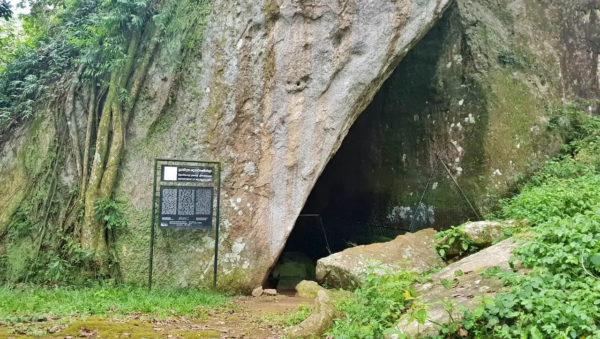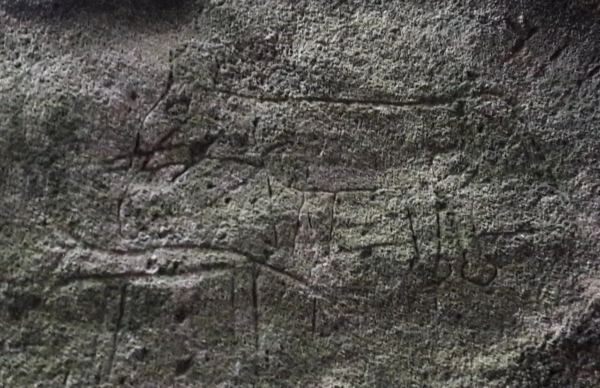Dorawaka Ethubandi Cave – venture into Neolithic Era – By Arundathie Abeysinghe

 Situated off the beaten track in Uragala in close proximity to Warakapola in *Kegalle District, Dorawakkanda Cave also known as Dorawaka Ethubandi Cave Prehistoric Site has yielded some of the most sensational archaeological findings in recent times including several *Brahmi inscriptions.
Situated off the beaten track in Uragala in close proximity to Warakapola in *Kegalle District, Dorawakkanda Cave also known as Dorawaka Ethubandi Cave Prehistoric Site has yielded some of the most sensational archaeological findings in recent times including several *Brahmi inscriptions.
Also known as “Athabandi Lena”, this cave comprises primitive rock paintings depicting animals, the sun and moon and some unidentifiable objects. According to research carried out in this location, the habitation of this cave is in the transition period from Mesolithic to Protohistoric. Prior to the excavations, the rock cave has been dated to the proto historic Mesolithic period. Considered as a major breakthrough in history and archaeology of Sri Lanka as evidence regarding the existence of civilization during the Neolithic Period in Sri Lanka was discovered, although, tosses and vestiges of man pertaining to this era are absent in the Cave similar to those found in surrounding rock caves.
As the site of the Cave is located amidst rubber plantations, it is necessary to walk a short distance and at first sight, it would be hard to make out the site, although, the Cave magically appears through the trees to bring to the fore two massive rectangular rocks that lean on each other. These two amazing structures form the entrance of the Cave. The sound of eerie cacophony of bats who dwell in the cave site welcomes visitors who dare to enter the dark cave.
There are several ancient carvings on the walls of these rocks that have been numbered by the Department of Archeology. Yet, a flashlight is necessary to make them out as the interior of the Cave is dark. These markings depict ancient scribbles known as “kurutu gee” (Graffiti).
Archaeologists are of the view that excavations conducted at the Dorawaka Rock Cave reveal significant information regarding the existence of an ancient civilization during the Neolithic Period, the transition period between the Stone Age and Copper, Bronze and Iron Ages which gradually stemmed from farming. Scholars believe that the carvings on the rock have been made with iron tools. Excavations have revealed evidence of fireplaces, pottery and millet grains and it is accepted that the Cave had been home to two or three families.
The petroglyphs are also found in the Cave. The drawings have been carried out on the inner side of the taller slab, approximately 1.9 meters (6.5 feet) above the ground. Scholars are of the view that these drawings are of *Vedda origin.
According to archaeologists, initial discovery of lettering system at Dorawaka Cave has been inscribed on an interior wall. There is also a linear diagram depicting two elephants and a reptile which have been recorded in the Journal of Ceylon – Antiquarian Register in 1918. There are also carvings of animals of which the most well-known is the carving of an elephant and its calf.
According to scholars, Dorawaka Cave was initially discovered in the 1940’s and dates to 6300 BC.

A significant historical and archaeological site situated in close proximity to Dorawaka Cave is Dedigama Suthigara Chaitya (also known as*“Kota Vehera”).
Dorawaka Ethubandi Cave is an archaeological protected monument declared by a government gazette notification published on November 22, 2002.
Distance from Colombo: Approximately 67 kilometers
Directions: From Colombo travel along Colombo – Kandy Road up to Warakapola and thereafter travel along Warakapola – Anguruwella (B457) road. Proceed approximately five kilometers through paddy fields and rubber plantations to reach the location where there is a fork on the road and turn left from this location to reach “Natha Devalaya” (where workers at the rubber plantations get their knives blessed before commencing their daily work). After proceeding further on this road “Bingala Thena Raja Maha Viharaya”(a recently restored ancient temple with several unique artifacts) can be reached. Thereafter, it is necessary to walk along the road on the left to reach the Dorawaka Rock Cave.
Image courtesy – amazinglanka.com
- Brahmi inscriptions – The earliest writing system developed in India after the Indus script and considered as an influential writing system. All modern Indian scripts as well as several hundred scripts that are in South Asia, Southeast and East Asia are derived from Brahmi.
- Dedigama – Situated approximately 75 kilometers from Colombo, Dedigma is a hamlet in Nelumdeniya in Kegalle District.
- Kegalle – Kegalle (known as “Kegalla” in Sinhala) is a large town in west-central Sri Lanka located on Colombo – Kandy Road, approximately 78 kilometers from Colombo and 40 kilometers from Kandy. Kegalle is the main town in Kegalle District.
- Veddas – Also spelled as “Veddah” and known as “Wanniyalaeto”, Veddas are a minority indigenous group of people in Sri Lanka. Considered as Sri Lanka’s aboriginal inhabitants prior to the 6th century bce, according to historical records, they were the children or descendants of Queen Kuweni, a *Yaksha and the wife of Sri Lanka’s legendary first King Vijay (5th century BC). Anthropologists date them to the Stone Age. Predominantly, hunter-gather people, the Veddas have been living harmoniously with nature.
- Yaksha – A broad class of nature-spirits connected with water, trees, the forest, treasure and wilderness. They appear in ancient and medieval era temples of South Asia and Southeast Asia as guardian deities.
“Kota Vehera” – commemoration of a royal birth – By Arundathie Abeysinghe
https://www.elanka.com.au/kota-vehera-commemoration-of-a-royal-birth-by-arundathie-abeysinghe/







